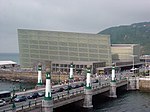San Telmo Museoa

San Telmo Museoa (English: San Telmo Museum, or STM) is a museum of the Basque society located in Donostia-San Sebastián, addressing old and contemporary Basque culture, arts and history in a European, global context. It moved to its current location in 1932, Zuloaga plaza in the old town, at the foot of the hill Urgull. It occupies a former Dominican monastery complemented by a 21st-century extension. San Telmo is presented as a museum and, at the same time, as a place to disseminate knowledge and create thought; it is an instrument to understand the present and build the future from encounters with the past and with our roots. In 2011, a major makeover of its facilities took place by adding an extension to the convent and reshaping its facilities along the lines of its new conceptual approach as a museum of the Basque society and citizenship. The museum received a Special Mention in the 2013 best European museum contest organized annually by the Museum Forum.
Excerpt from the Wikipedia article San Telmo Museoa (License: CC BY-SA 3.0, Authors, Images).San Telmo Museoa
Santa Korda kalea, San Sebastián Parte Zaharra - Parte Vieja (Erdialdea)
Geographical coordinates (GPS) Address Website Nearby Places Show on map
Geographical coordinates (GPS)
| Latitude | Longitude |
|---|---|
| N 43.324922 ° | E -1.984917 ° |
Address
San Telmo Museoa
Santa Korda kalea
20003 San Sebastián, Parte Zaharra - Parte Vieja (Erdialdea)
Autonomous Community of the Basque Country, Spain
Open on Google Maps










